
This painting was conserved in 2018 by Giulia Campagnari at the National Gallery of Ireland’s conservation studio through a shared NGI-CAG-IMMA Conservation Internship.
Significance
Festival Scene is among Sylvia Cooke-Collis’ most strikingly individual paintings in an Irish public collection. In its palette and bold outlines, this work embodies stylistic elements that resonate with Fauvism and the work of Raoul Dufy (1877-1953), while also echoing the artist’s training with Irish modernist, Mainie Jellett (1897-1944).
The painting is one five works by the artist that were presented to Crawford Art Gallery in 1974 by the Friends of the National Collections of Ireland through the Sylvia Cooke-Collis Bequest.

CAG.0136 Sylvia Cooke-Collis, Festival Scene, undated, oil on canvas, 141 x 106 cm. Presented, Friends of the National Collections of Ireland (Sylvia Cooke-Collis Bequest). © the artist’s estate.
Sylvia Cooke-Collis (1900-1973), who had grown up at Clifford House and Annes Grove, County Cork, initially studied at Crawford Municipal School of Art under John Power. This was a time when the Collection was rapidly expanding to include work by Harry Clarke, George Clausen, Paul Henry, Seán Keating, John Lavery, Anne St John Partridge, and Jack B. Yeats.
The artist exhibited regularly with Dublin Painters’ Gallery, Grafton Gallery, and The Water Colour Society of Ireland, as well as at Munster Fine Art Club, Royal Ulster Academy, Irish Exhibition of Living Art, and Imperial Hotel, Cork.

Sylvia Cooke-Collis at Imperial Hotel, Cork with sculptor Séamus Murphy, December 1952. Photo courtesy Julian Walton.
Aside from Jellett, among Cooke-Collis’ creative circle of friends were painters Evie Hone, Stella Frost, and Basil Rákóczi, writer Elizabeth Bowen, and sculptor Séamus Murphy (who would create her headstone).
Assessment
Condition checking revealed that the painting was in a very poor state. Rusted tacks had caused oxidation and ripping of the canvas at the tacking points. The canvas itself was loose on the stretcher and suffered from severe distortion, with several pronounced bulges.
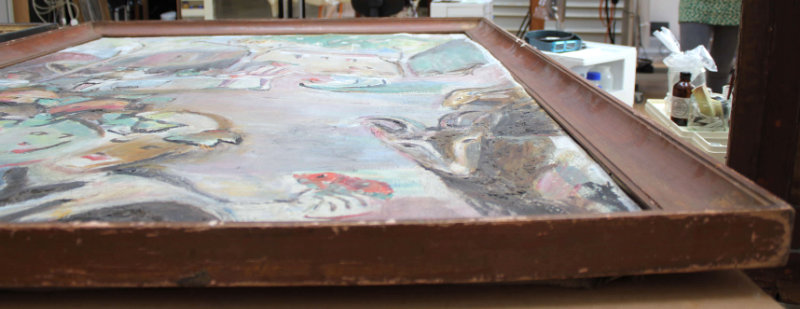
Before starting treatment
These issues had aggravated the cracking of the thick and rigid ground and oil paint layer, most severely on the areas of significant deformation, and triggered delamination, tenting, and flaking, which had in turn lead to several paint losses over time.
Dirt and dust also gave the unvarnished surface of the painting a dull appearance. Accumulation of dust and debris were present on the verso (reverse), as well as on the stretcher and frame. There were also signs of a non-active infestation of woodworm in the corner joins of the strainer.
The painting had also been fitted to the frame with bent nails, which placed it at risk.
It was decided that this painting would benefit significantly from treatment at National Gallery of Ireland’s conservation studio. Areas of paint at risk from further loss were faced with Japanese paper before it was packed for transport.
Consolidation and Cleaning
Once it had arrived safely at National Gallery of Ireland’s conservation studio, the painting was unpacked, de-framed, removed from its stretcher, and dusted.

Taken off stretcher
Localised consolidation of flaking paint was conducted using Beva 371 adhesive in White Spirit (15%), which was reactivated after 24 hours by application of heat with a hot spatula.

Surface cleaning test
Surface cleaning tests with deionised water indicated the sensitivity of some colours to aqueous cleaning methods. Following further tests with solvents White Spirit, ShellSol A, and ShellSol D40, the latter was chosen as it allowed a gradual cleaning.

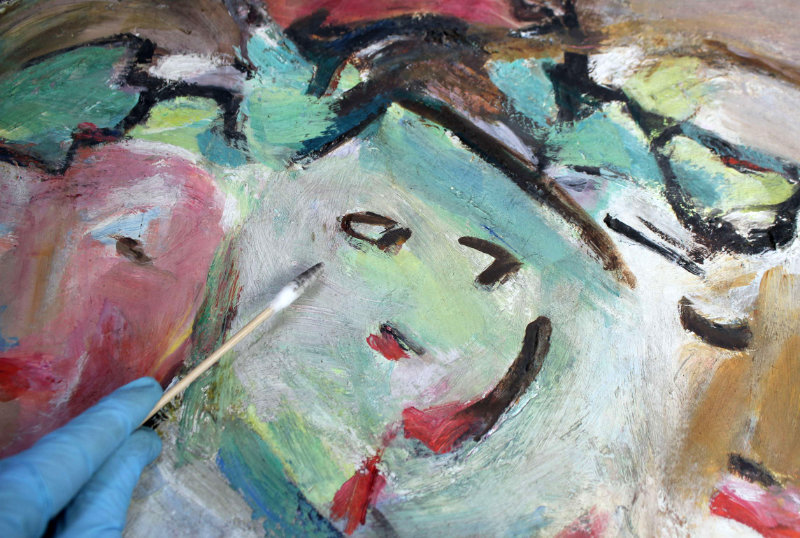
Treatment
The painting was placed on a heated vacuum table. A 15% solution of Beva 371 (adhesive) in White Spirit was applied to impregnate the canvas, ground, and paint layers.
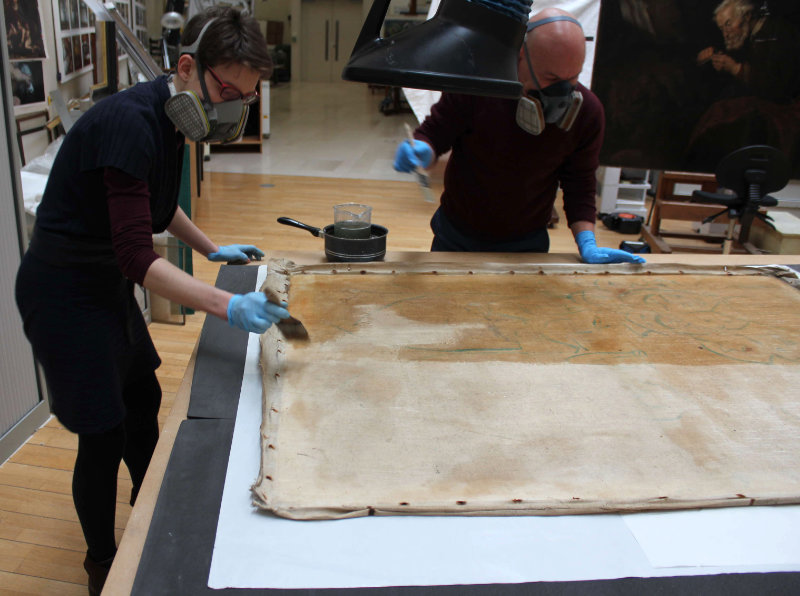
Consolidation of paint from verso
The painting was left on silicone release paper until complete evaporation of the solvent had occurred. The margins were then flattened with a heated spatula.
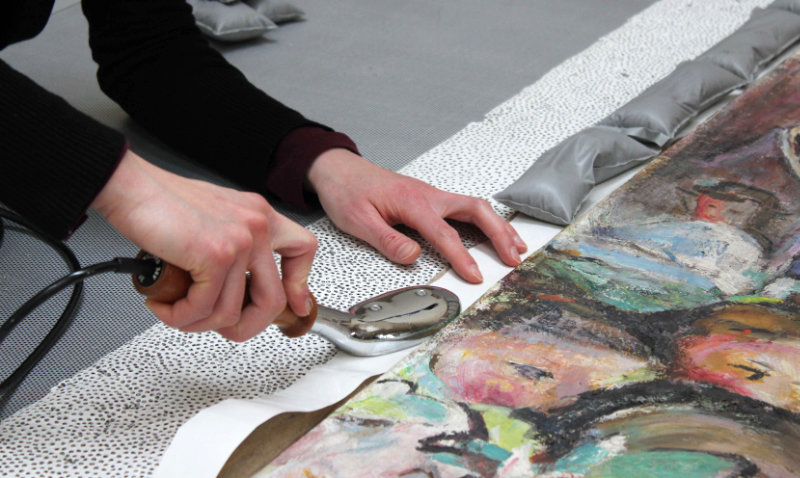
Flattening the margins
The Beva 371 adhesive was then reactivated by application of controlled heat (68-70°C). Planar distortion was eliminated thanks to suction on the heated vacuum table and keeping the painting under weight for the following day and night.
An indication of good penetration of the solution, glossy lines of Beva 371 on the recto (front) were subsequently removed with ShellSol D40.
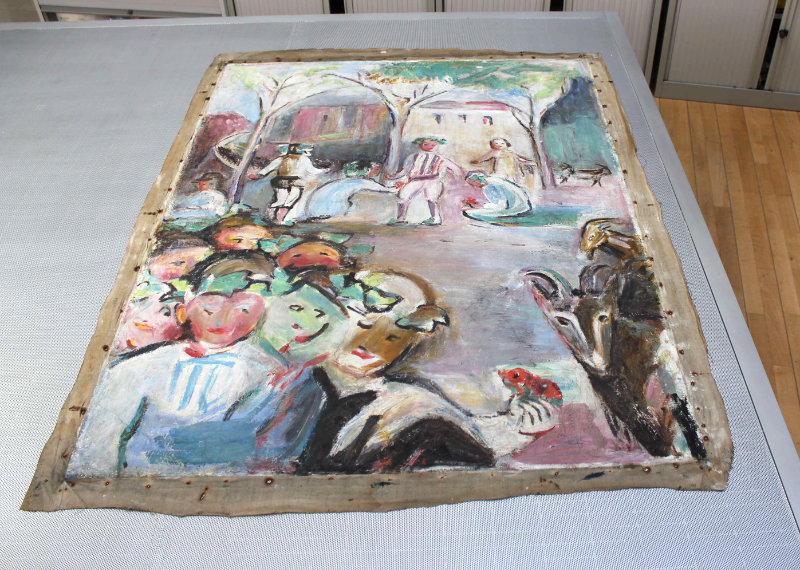
After treatment on heated vacuum table
The conservator then applied Beva 371 solution on areas of flaking paint and bulges, which were then kept under weight to eliminate distortion.
Re-stretching, Retouching, and Reframing
As a preventative measure, the woodworm holes in the painting’s strainer were sealed with beeswax and the painting could then be re-stretched.
Stainless steel staples were applied at the margins, with cotton tape interposed to protect the canvas. The excess of canvas was then secured on the verso (reverse).
Where areas of past paint loss existed, these were infilled with gesso and retouched in watercolours.
The painting was reframed and fitted to museum standard, with flexible steel slips, spacers, felt lining on the frame rebate, and a foamcore backing board. The original labels for the painting were inserted into Melinex polyester sleeves and secured to the backing board.
Display
Since its conservation, Festival Scene has returned to display in a number of exhibition contexts, most recently in BEHIND THE SCENES: Collection at Work (26 November 2022 – 10 April 2023) in which this conservation work was highlighted.
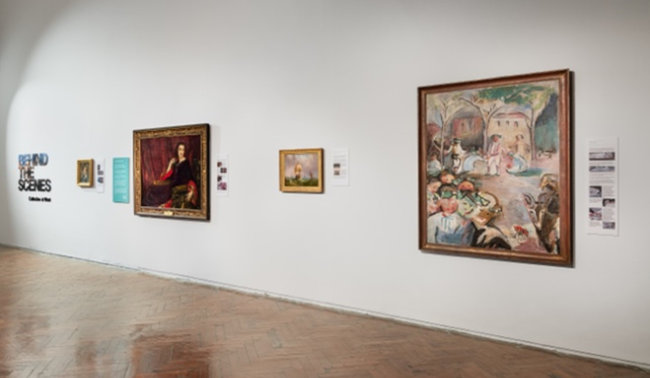
Photo: Jed Niezgoda
Text adapted from Conservation Report (2018) by Giulia Campagnari.
Learn more about Sylvia Cooke-Collis’ Festival Scene here:
Work Of The Week | 1 February 2021 - Crawford Art Gallery
Emmett Place, Cork, Ireland
T12 TNE6
Tel: 021 480 5042
info@crawfordartgallery.ie
Opening Hours
N.B. Last entry is 15 minutes before closing
Monday–Saturday 10.00am–5.00pm*
Thursday until 8.00pm
Sundays and Bank Holidays
11.00 am–4.00pm
© 2024 www.crawfordartgallery.ie